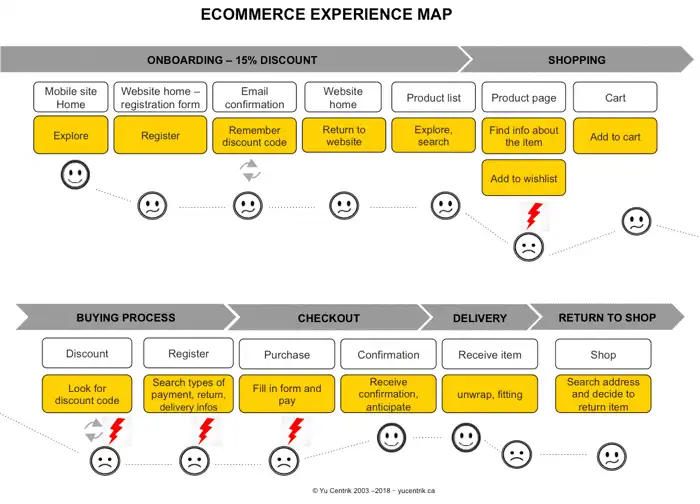This map illustrates the customer or user’s journey as it is actually experienced. There are different ways to map these experiences, multiple examples are available on the Web, and all of the forms are useful—from the simplest to the most sophisticated. The journey identifies and visually illustrates multiple points of contact with the customer, positive and negative experiences with the organization and the emotions generated as a result.
What is the Customer Journey Map?
In a nutshell, the Customer Journey Map is a powerful tool for sharing the customer experience with all of the team members involved (product, design, marketing, customer service, BI and IT and more). The simplicity of its visual representation can quickly convince key players of the importance of improving one or more elements of customer service and help them identify any missed opportunities.
The customer journey map represented here is a true omni-channel experience:
http://www.technologia.com/~/media/Images/Publications/Gestion de projets/Experience-map-English/Journey-map-english.png?h=542&la=en&w=700
This is an online purchase that starts on the mobile web site of a well-known Canadian brand that sells its products online and in-store. The objective here is to demonstrate that the site presents opportunities for improvement that would significantly reduce the shopping cart abandonment rate and increase the conversion rate.
Customer Journey Mapping: a concrete example
Two representations of an online purchase are shown here, one describing the tasks and the other visually expressing the pains and the gains.

This particular scenario starts with a need or a desire to buy some yoga pants. A quick glance at the smart phone reveals that buying this type of product requires a slightly larger screen.
By continuing on the web site of the same company, a large pop-up invites the customer to get 15% off immediately upon registration. It's pretty enticing, so why not!
Registration is fast. All you need to do is provide 2 to 3 pieces of basic information, enter your email address and, boom, you get a discount. At least that's what the user expects. But, as the map shows, this is where things get complicated—validation of the email address is required before you can get the discount.
Obviously, this causes an interruption in the shopping task—you have to leave the web site to check your mail and confirm your email address—which could prove fatal to the merchant. And it gets worse if you don’t take note of or remember the discount code that was sent by email because you’ll need to go into your mailbox to find it again (as was the case in this experiment).
The more we try to move forward—searching, selecting and adding the product to our cart, the more things get complicated. Information about the size, color, material, and product view are difficult to find. Information about the type of payment accepted and the conditions of returning the items are missing at the very moment when one should be reassuring the future customer and making him feel special.
The purchase form does not allow you to see the selected item at any time and the steps are not predictable. This is basically an accordion principle where, once you move onto the next step, the previous step disappears. No doubt, many potential buyers have probably given up at this point. However, since our goal was to make it to the end of the process, we hung on until we received confirmation of the purchase. The confirmation arrived rather quickly by email, providing information on the expected delivery date (which was rather short).
The product arrived quickly—only three days after our online purchase. Unfortunately, the pants were too big and we decided to return them to the store. The team on the floor did not seem aware of the procedures for returning purchases made online. They did tell us, however, that this type of legging should be purchased one size smaller. Why then was this not mentioned on the site from the start? Several phone calls later, we got our refund, leaving a little disappointed since the smaller size was not available in store.
Disappointing experiences affect your bottom line
We encountered multiple problems on this site which were linked to a lack of respect for user interface standards, usability standards, lack of knowledge about trust and online security issues, and many disruptions in the omni-channel e-commerce cycle (people in stores should be aware of what is happening online).
Consumers still face many barriers that prevent them from fully embracing a digital service channel. We live in an era that is service oriented—service is everything. Consumers are becoming more demanding, their expectations are high and their loyalty is low. Even adopting a loyalty program will not prevent customers from swapping brands, suppliers or services.
How to enhance your customers’ experience
Companies must adapt quickly and implement strategies in order to keep their customers! When organizations are asked how important User Experience (UX) is for them, all of them say that it is an integral part of their strategy. In reality, however, these organizations are still far from having operationalized their desire to offer optimal experiences. As a result, they fall short of their expectations and end up with dissatisfied customers, consumers and users.
Creating a user experience map builds internal knowledge, creates a consensus within the organization, and helps create fluid and consistent customer experiences.
The three levels of UX certifications offered at Technologia, in partnership with Yu Centrik, encompass all facets of what user experience really is as well as its intrinsic value. There is a wide range of activities and tools that can be integrated into the development cycle during the pre-design phase, as well as during and after use, to ensure delivery of a product and service that is easy to use, that meets the needs of customers and keeps them loyal.
These courses are designed for IT and digital managers including product owners, account managers, product managers, project managers and marketing managers. In fact, our UX training courses are perfect for anyone who is interested in better understanding UX and/or how to integrate UX activities into their projects.
* Adapt this customer experience map to your context. It can be referred to as the user experience map, consumer experience map, patient map, etc.







